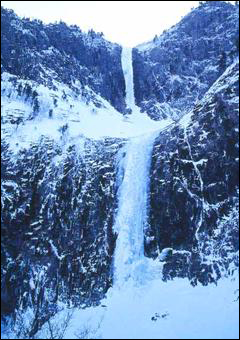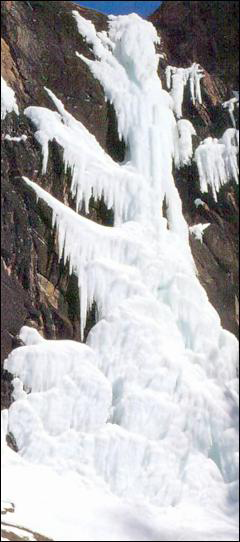CAC CONTENTS
-

-
CAC Contents
-
Winter Trill in Korea by Cho sung dae
- Outline
- Mountaineering around the capital
- Mt. Sorak with fascinating sights
- A great volcaic upheaval
- Scaling of high mountains aborad
- Overseas expeditions by CAC & KAF
- Vigorous climbing movement in Korea
- New Start
- Korean Rock by Rick Ruffin
- Seoul Big Slab by Rick Ruffin
- Winter Trill in Korea by Cho sung dae
Winter Trill in Korea by Cho sung dae
Towangpok Climbing(Winter thrill in korea)
-

-
While in orther seasons they pursue rock climbing, in winter Korean climbers take to scaling the walls of ice created when the cold winds freeze the mountain waterfalls. For climbers in the Seoul area, the usual place to practice rock-climbing is Insu peak on Mt.Pukhan.
When the temperature drops to a level at which the fingers are too numb for ordinary rock-climbing, the climbers pull their ice-climbing gear out of the closets and loft it`s been stored in all year and give it a through checking over.They remove and rust that may have formed, apply oil, and ready their double-insulated plastic boots and ice screws.
They monitor the daily weather forecasts, waiting for the falls to freeze.
Each region has its own favorite falls. The one most frequented by climbers from Seoul is Kugok falls on Mt.Ponghwa located in Kangch`on, Nam-myon, Chunsong-gun, Kangwon Province. Kukog falls is on the shady side of the mountain, so it freeze faster than any of the falls in the seoul vicinity.
This falls is 70 meters high and has an incline of 60 to 70 degrees, making it an excellent place to practice in preparation for scaling Korea`s biggest waterfall, Towangsong Falls.
The waterfalls nearest to Seoul include Kuch`onun Falls on Mt.Pukhan, Hoeryonggkol Fall on Mt Tobong, chunghong Falls on Mt. Sap`ae, and Ullyu falls on Mt. Surak.
But climbers don`t care so much about how near or far falls is;they are much more interested in how soildly the falls are frozen and how challenging a climb they present. That`s why they head for the more distant and difficult Kugok Falls mentioned above or for the various falls on Mt. Worak in the national park in south Ch`ungch`on Province and those on Mt. Sorak.
The ice-climbing doesn`t get into full swing until the last part of December and lasts into the following february. Kugok falls and T`owangsong Falls never disppoint climber s, for they always have abundant water, and therefore abundant ice, even in years of drought.
No one is sure exactly when the sport of ice-climbing was introduced to Korea, but certain mainstay members of the Corean Alpine Club, which has lead the mountain-climbing movement here since its beginnings, probably did some ice-climbing in the Chunlbul-dong Valley of Mt.Sorak when they visited there in winter. In view of the fact that the first pickels(ice axes)were manufactured in korea in the early 1960`s, it`s would seem that by that time ice-climbing had already become a common pursuit.
In the early 1970s the Corean Alpine Club sent some its young members to study at the Ecole Nationale de Ski et d`Alpinisme in Chamonix, France, the
home of alpinism. There they learned advanced climbing techiniques and helped Korean climbing get on the right track when they returned to their homeland. It is doubtless through their influence that French climbing terminology, such as piolet(ice axes), spread among moutain-climbers here.
-
After the introduction of French ice-climbing technique, Korean climbing technique and equipment continued to develop and progress a local climbers passed on front-pointing techniques learned on the hard "blue"ice of the climates of Eastern Europe and Canada.
Until the 1970s Towangsong Falls was the focus of interest among Korean climbers.
This falls, which is located in Sorak-dong at the enterance to the mt.sorak area, looks like a column of water connecting heaven to earth. it seemed to dare climbers with its formidable height. It was first climbed successfully in 1977 by Song Pyong-Min and Pak Young-Bae of the Crony Alpine Club.
It took them no less than tree days two nights to make all the way from the bottom to the top.To scale Towangsong Falls is the dream of virtually every Korean Climber. It is the longest ice-climbing course on a single waterfall in the Orient. Before it was conquered many a climber lost his life there, but today with the progress we`ve made in equipment and technique, the climb, which originally took three days, has been made in as little as an hour by some climbers. Since1990 the record for the shortest time has been broken year after year.
The basic eqipment needed for ice-climbing includes specially designed boots, a safety helmet, crampons, a pickel, and ice screws. Today double-walled plastic boots are favored over the traditional leather, but whether the climber wear plastic or leather, if he wants to use the front pointing technique the boots must have two to four points in the toe and must have rigidly inflexible soles.
-

The crampons used on climbing boots generally have twelve to fourteen points. Rope is the climber`s lifeline, and for the ice-climber it must be rope that will not freeze. There was time when the same sort of nylon rope used for rock-climbing was also employed in ice-climbing, but today`s climbing, but today`s climbers use a special dry type that does not absorb moisture.
Of course, it`s important to have a compleate set of excellent equipment, but most important of all in ice-climbers is the climber`s ability and a mind that dose panic. additionally, the climber needs the will to climb and climb. Without that will, a frozen waterfall looks like nothing more than a lovely winter scene, but with it, it presents a thrilling opportunity that cannot be passed up.


 ENGLISH
ENGLISH


